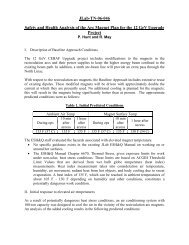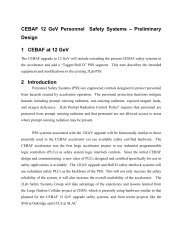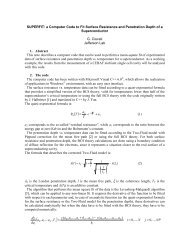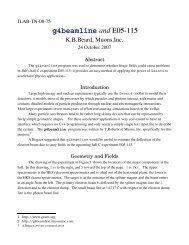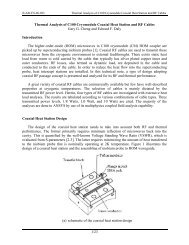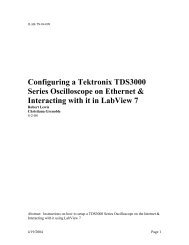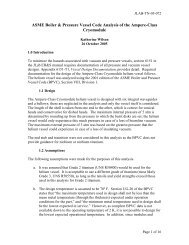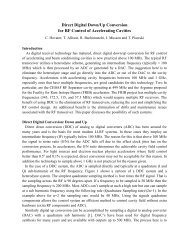Workshop on Polarized Electron Sources and Polarimeters
Workshop on Polarized Electron Sources and Polarimeters
Workshop on Polarized Electron Sources and Polarimeters
Create successful ePaper yourself
Turn your PDF publications into a flip-book with our unique Google optimized e-Paper software.
Ultra Cold Photoelectr<strong>on</strong> Beams for<br />
I<strong>on</strong> Storage Rings<br />
D. A. Orlov a , C. Krantz a , A. Shornikov a , M. Lestinsky a , J. Hoffmann a ,<br />
A.S. Jaroshevich b , S.N. Kosolobov b , A.S. Terekhov b <strong>and</strong> A. Wolf a<br />
a Max-Planck-Institut für Kernphysik, 69117, Heidelberg, Germany<br />
b Institute of Semic<strong>on</strong>ductor Physics, 630090, Novosibirsk, Russia<br />
Abstract. An ultra cold electr<strong>on</strong> target with a cryogenic GaAs photocathode source, developed<br />
for the Heidelberg TSR, delivers electr<strong>on</strong> currents up to a few mA with typical kinetic energies<br />
of few keV <strong>and</strong> provides unprecedented energy resoluti<strong>on</strong> below 1 meV for electr<strong>on</strong>-i<strong>on</strong><br />
recombinati<strong>on</strong> merged-beam experiments. For the new generati<strong>on</strong> of low-energy electrostatic<br />
storage rings, cold electr<strong>on</strong> beams from a photocathode source can bring additi<strong>on</strong>al benefits,<br />
improving the cooling efficiency of stored i<strong>on</strong>s <strong>and</strong> making it possible to cool even heavy, slow<br />
molecules by electr<strong>on</strong> beams of energies of <strong>on</strong>ly a few eV or even below.<br />
Keywords: photocathode, electr<strong>on</strong> beams, electr<strong>on</strong> cooling, electr<strong>on</strong> target, storage ring.<br />
PACS: 52.25.Xz , 29.25.Bx, 29.20.D, 85.60.Ha, 34.80.Lx, 37.10-x<br />
INTRODUCTION<br />
Semic<strong>on</strong>ductor photoemitters with negative electr<strong>on</strong> affinity (NEA) are widely used in<br />
various scientific experiments for the generati<strong>on</strong> of spin-polarized, short bunched<br />
high-density electr<strong>on</strong> beams. Photoelectr<strong>on</strong> sources also offer the possibility to employ<br />
extremely cold electr<strong>on</strong>s with emissi<strong>on</strong> energy spread of about the cathode<br />
temperature, which can be as low as 7 meV at 100 K [1]. One of the main difficulties<br />
is to keep the beam cold as a space charge causes beam divergence at high currents.<br />
To avoid this heating, high magnetic guiding field is used in the electr<strong>on</strong> coolers of<br />
storage rings, which decouples transverse <strong>and</strong> l<strong>on</strong>gitudinal electr<strong>on</strong> moti<strong>on</strong>s. Electr<strong>on</strong>i<strong>on</strong><br />
merged beams at storage rings have also opened a new domain for electr<strong>on</strong>-i<strong>on</strong><br />
recombinati<strong>on</strong> studies where ultra cold photoelectr<strong>on</strong> sources can bring great benefits<br />
in high-resoluti<strong>on</strong> measurements. A cryogenic photocathode target was developed<br />
[2,3,4] for recombinati<strong>on</strong> measurements at the Heidelberg Test Storage Ring (TSR)<br />
<strong>and</strong> is in operati<strong>on</strong> since 2002 delivering dc electr<strong>on</strong> beams of mA currents <strong>and</strong> with<br />
ultra-cold temperatures below 1 meV [4,5]. For the upcoming electrostatic Cryogenic<br />
Storage Ring (CSR), where the cooling of stored slow i<strong>on</strong>s has to be performed at<br />
typical electr<strong>on</strong> energies of 10 eV down to the sub-eV range, the impact of the cold<br />
photocathode source can be of high additi<strong>on</strong>al importance. Indeed, at low energies of<br />
1-100 eV the electr<strong>on</strong> current drops down to the A range due to a limited gun<br />
perveance, which str<strong>on</strong>gly decreases the cooling efficiency. To make cooling possible,<br />
electr<strong>on</strong> beams of low temperatures have to be used [6]. In this paper, we present the



